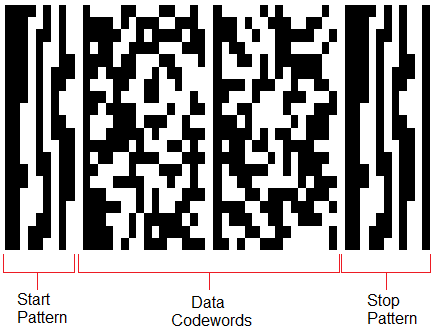The MicroPDF417 barcode is a variable-length, alphanumeric 2D barcode with Solomon-Reed Error Correction. MicroPDF417 is referred to as a stacked linear barcode as its 2-dimensional structure consists of vertical stacks of horizontal symbols. MicroPDF417 is based on the PDF417 standard and designed for maximum area efficiency, but without the PDF417's maximum data capacity. It is the perfect candidate to use where PDF417 is applicable but there is a limited amount of space.
Example Barcode
The following example barcode encodes the information "abcdefghijklmnoqrstuvwxqwertyuiop[]asdfghjkl;'z" as an MicroPDF417 barcode:

Details
MicroPDF417 and its unabridged version, PDF417, are unique among 2D symbologies - they are stacked linear barcodes that can be read by linear scanners. Each MicroPDF417 barcode can have between 4 and 44 rows, between 1 and 4 data columns, up to 125 data codewords, and a fixed amount (between 7 and 50) of error correction codewords. This allows encoding of up to 150 bytes, 250 alphanumeric characters, or 366 numeric digits. 1
Barcode Breakdown
The MicroPDF417 symbol is comprised of a couple of components:
- Start Pattern
- Data Codewords - The codewords between the start and stop patterns, where the actual data is encoded.
- Stop Pattern
Each codeword consists of 4 black bars spaced across the 17 modules that make up the codeword, which is where the name PDF417 originates. Since MicroPDF417 uses base 929 encoding, each codeword represent a number between 0 and 928.
Basic Characteristics
- Encodable character set:
- Text Compaction mode permits all printable ASCII characters to be encoded, i.e. values 32 to 126 inclusive in accordance with ISO/IEC 646, as well as selected control characters.
- Byte Compaction mode permits all 256 possible 8-bit byte values to be encoded. This includes all ASCII characters with values from 0 to 127, inclusive, and provides for international character set support.
- Numeric Compaction mode permits efficient encoding of numeric data strings.
- Up to 811,800 different character sets or data interpretations.
- Various function codewords for control purposes.
- Symbol character structure:
- (n, k, m) characters of 17 modules (n), 4 bar and 4 space elements (k), with the largest element 6 modules wide (m).
- Maximum possible number of data characters per symbol (for a maximum size MicroPDF417 symbol):
- 125 data codewords which can encode
- Text Compaction Mode - 250 characters (2 data characters per codeword).
- Byte Compaction mode - 150 characters (1,2 data characters per codeword).
- Numeric Compaction mode - 366 characters (2,93 data characters per codeword).
- 125 data codewords which can encode
- Symbol Size:
- Number of rows - 4 to 44 (available in defined combinations with number of columns). Valid values are:
1x11, 1x14, 1x17, 1x20, 1x24, 1x28, 2x8, 2x11, 2x14, 2x17, 2x20, 2x23, 2x26, 3x6, 3x8, 3x10, 3x12, 3x15, 3x20, 3x26, 3x32, 3x38, 3x44, 4x4, 4x6, 4x8, 4x10, 4x12, 4x15, 4x20, 4x26, 4x32, 4x38, 4x44
- Number of data columns - either one, two, three, or four.
- Width in modules - 40X, 57X, 84X, or 101X including quiet zones.
- Maximum codeword capacity - 176 codewords.
- Maximum data codeword capacity - 125 codewords.
- Number of rows - 4 to 44 (available in defined combinations with number of columns). Valid values are:
- Number of error correction codewords:
- fixed for each available row/column combination, ranging from 7 to 50 codewords per symbol and reserving from 28% to 67% of codewords for error detection and correction, depending on symbol size.
- Non-data overhead:
- per row:
- 23 modules for the one- and two-column versions; 33 modules for the three or four-column version, including quiet zones.
- per row:
- Code type:
- continuous, multi-row bar code symbology.
- Character self-checking:
- Yes.
- Bi-directionally decodable:
- Yes.
Differences Between MicroPDF417 and PDF417
| MicroPDF417 | PDF417 |
|---|---|
| Maximum possible number of data characters per symbol 125 data codewords which can encode: 1) Text Compaction Mode: 250 characters (2 data characters per codeword). 2) Byte Compaction mode: 150 characters (1,2 data characters per codeword). 3) Numeric Compaction mode: 366 characters (2,93 data characters per codeword). |
Maximum possible number of data characters per symbol: 925 data codewords which can encode: 1) Text Compaction mode: 1 850 characters (at 2 data characters per codeword). 2) Byte Compaction mode: 1 108 characters (at 1,2 data characters per codeword). 3) Numeric Compaction mode: 2 710 characters (at 2,93 data characters per codeword). |
| Symbol Size: 1) Number of rows: 4 to 44. 2) Number of data columns: either one, two, three, or four 3) Width in modules: 40X, 57X, 84X, or 101X including quiet zones 4) Maximum codeword capacity: 176 codewords. 5) Maximum data codeword capacity: 125 codewords. |
Symbol size: 1) Number of rows: 3 to 90. 2) Number of columns: 1 to 30. 3) Width in modules: 90X to 583X including quiet zones. 4) Maximum codeword capacity: 928 codewords. 5) Maximum data codeword capacity: 925 codewords. |
| Number of error correction codewords: fixed for each available row/column combination, ranging from 7 to 50 codewords per symbol and reserving from 28% to 67% of codewords for error detection and correction, depending on symbol size. | Selectable error correction: 2 to 512 codewords per symbol. |
Managing Organization
MicroPDF417 is governed by ISO/IEC 24728:2006. 1
Similar Barcode Types
Related Barcodes
The MicroPDF417 barcode represents a condensed version of the PDF417 barcode.
References
- "MicroPDF417 Bar Code Symbology Specification." ISO/IEC 24728:2006, ISO/IEC, June 2006, www.iso.org/standard/38838.html.
For additional background and use-case information see our MicroPDF417 barcode page.
For more information, see the Barcode Xpress SDK product page or try our online demos.
